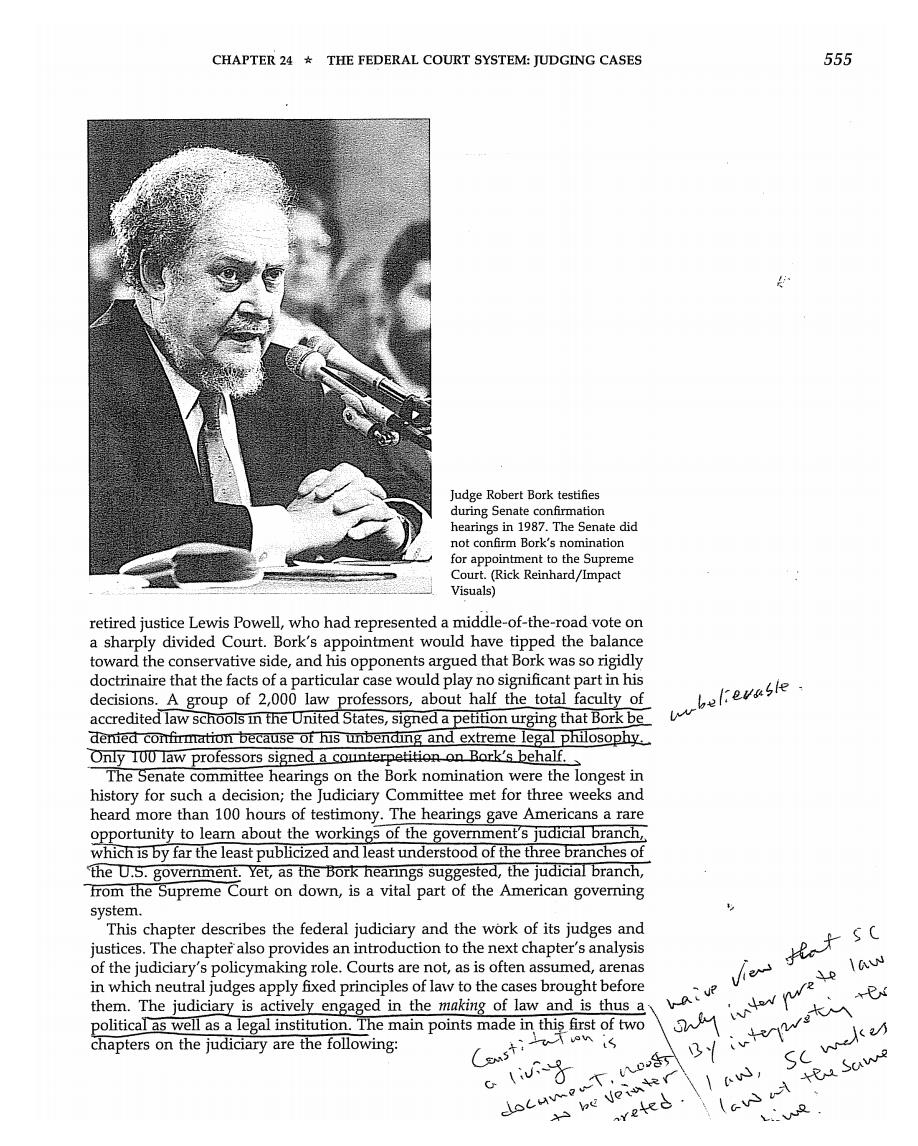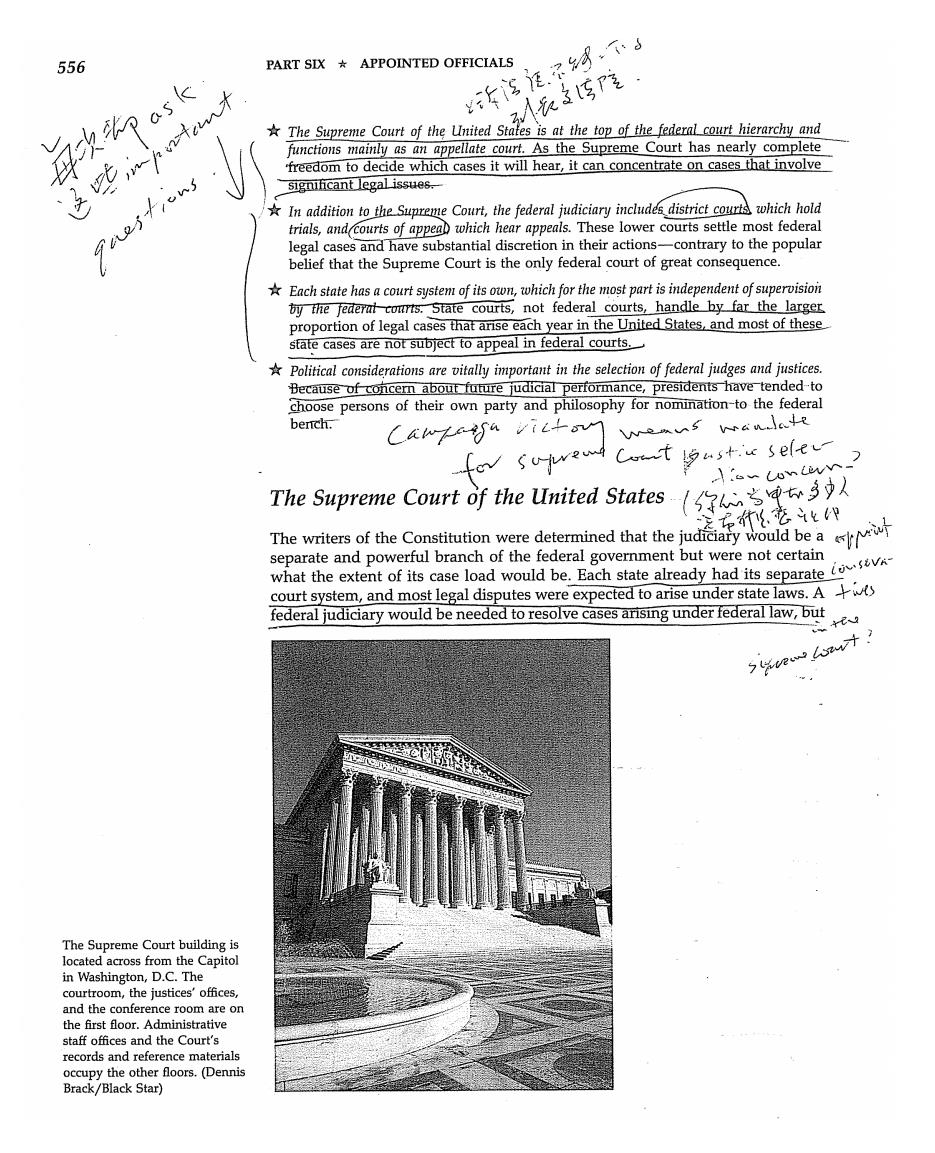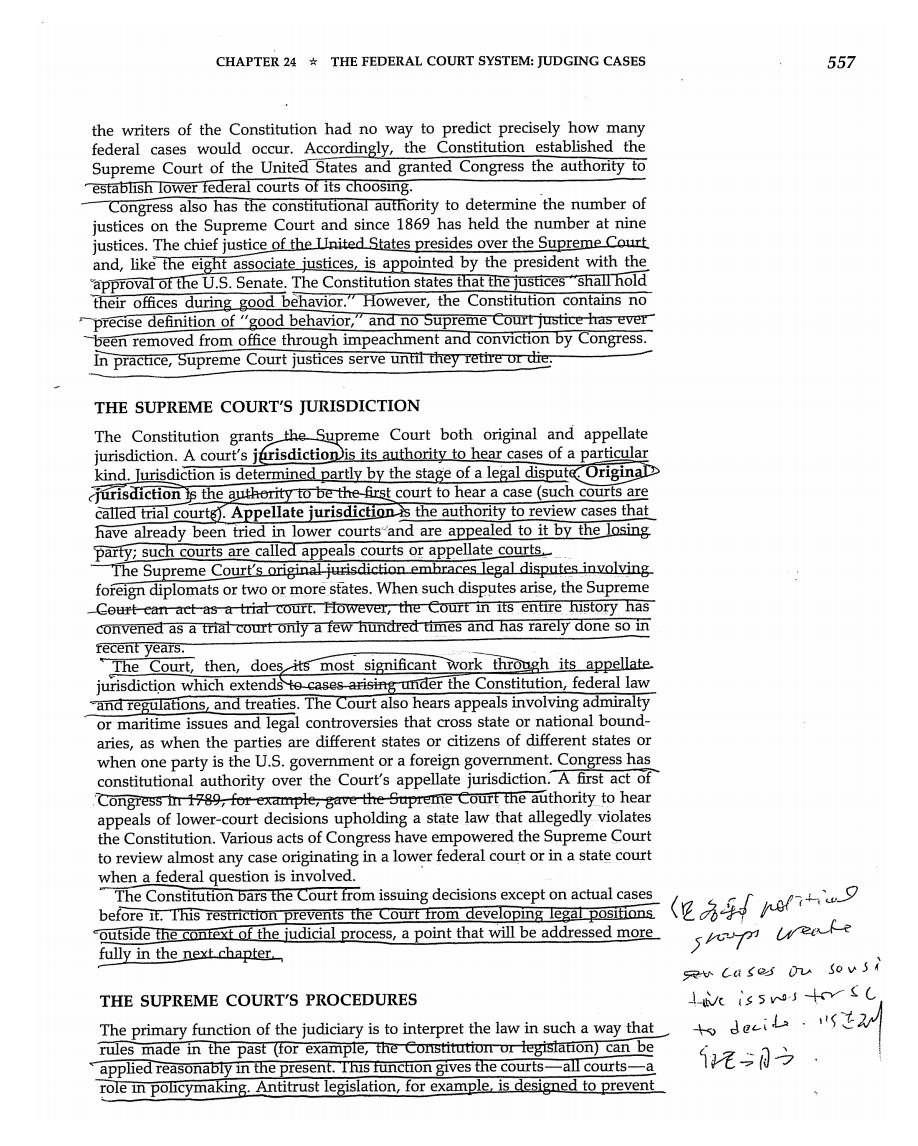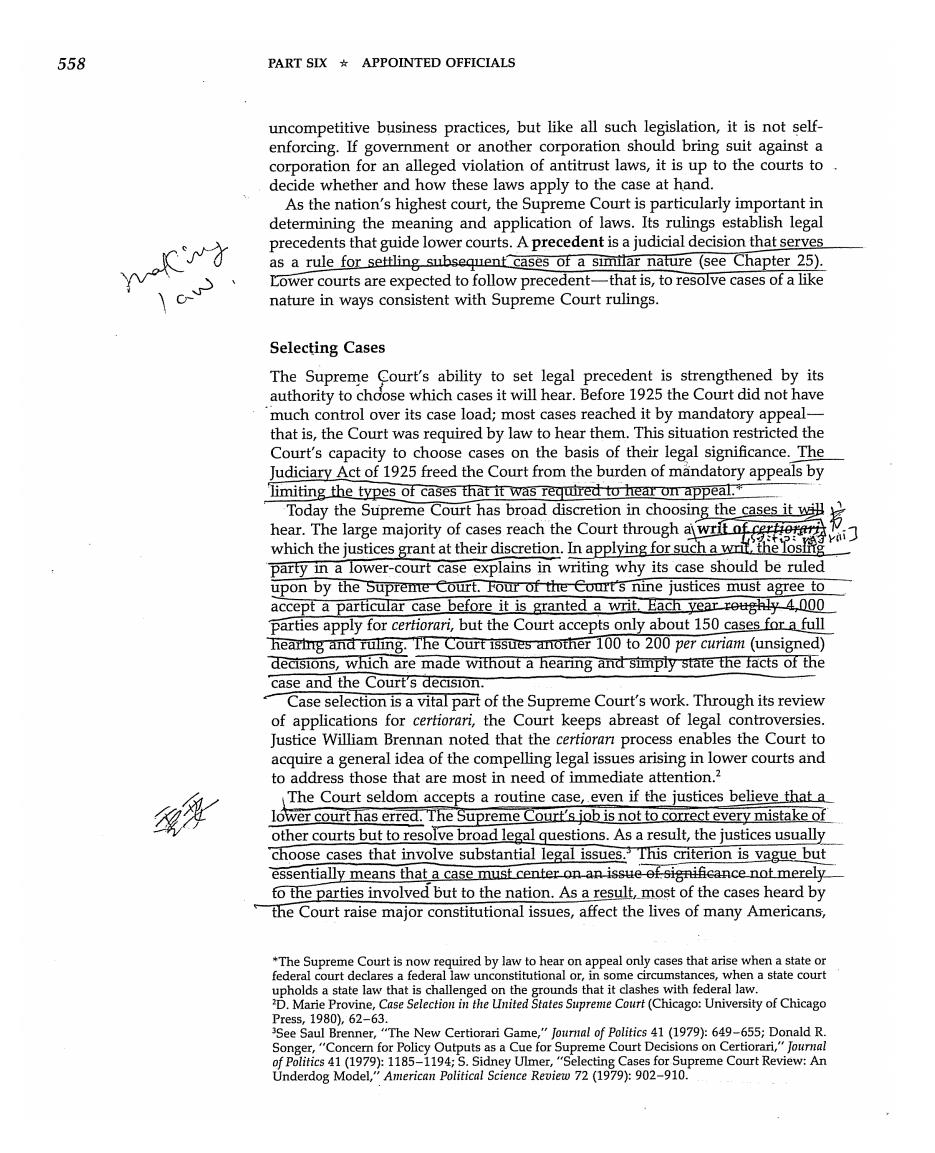
℃y THE FEDERAL COURT SYSTEM:JUDGING CASES It is emphatically the province and duty of the judicial department to say what the law is Those who apply the rule to particular cases,must of necessity expound and interpret that rule.If two laws conflict with each other,the courts must decide on the operation of each. John Marshall 小9风初 Cho or two months in the fall of 1987,one issue commanded Americans' attention:whether Robert Bork would be confirmed by the U.S.Senate to a seat on the Supreme Court of the United States.Bork was a former Yale and Chicago law professor,had been solicitor general of the United States,and was serving as a U.S.Court of Appeals judge at the time of his nomination by President Ronald Reagan.In the view of some legalists,including former chief justice Warren Burger,Bork was the best-qualified nominee to the Supreme Court in a half-century. Yet the U.S.Senate ultimately rejected Bork's nomination,mostly because of his controversial legal positions.In his writings Bork had argued that the 1964 Civil Rights Act's prohibition on discrimination in public accommodations had no constitutional justification,that the Supreme Court's "privacy"decisions (including its ruling that women have a right to choose abortion)were constitutionally unsound,and that antitrust laws should not be vigorously applied to prevent corporation mergers.These views prompted a wide array of minority,consumer,and women's groups to oppose Bork.Even the American Civil Liberties Union(ACLU),which had a long-standing policy of not taking a position on Supreme Court nominees,came out against bork's confirmation. Bork might have withstood his critics if it were not that his vote on the Supreme Court would have been pivotal.He was nominated to replace the Marbury v.Madison,1 Cranch 137 (1803). 554

CHAPTER 24 THE FEDERAL COURT SYSTEM:JUDGING CASES 555 Judge Robert Bork testifies during Senate confirmation hearings in 1987.The Senate did not confirm Bork's nomination for appointment to the Supreme Court.(Rick Reinhard/Impact Visuals) retired justice Lewis Powell,who had represented a middle-of-the-road vote on a sharply divided Court.Bork's appointment would have tipped the balance toward the conservative side,and his opponents argued that Bork was so rigidly doctrinaire that the facts of a particular case would play no significant part in his decisions.A group of 2,000 law professors,about half the total faculty of accredited law schools in the United States,signed a petition urging that Bork be urbelevasle. denied confurmation because of his unbending and extreme legal philosophy. Only 100 law professors signed a counterpetition on Bork's behalf. The Senate committee hearings on the Bork nomination were the longest in history for such a decision;the Judiciary Committee met for three weeks and heard more than 100 hours of testimony.The hearings gave Americans a rare opportunity to learn about the workings of the government's judicial branch, which is by far the least publicized and least understood of the three branches of the U.S.government.Yet,as the Bork hearings suggested,the judicial branch, from the Supreme Court on down,is a vital part of the American governing system. This chapter describes the federal judiciary and the work of its judges and justices.The chapter also provides an introduction to the next chapter's analysis of the judiciary's policymaking role.Courts are not,as is often assumed,arenas in which neutral judges apply fixed principles of law to the cases brought before aue比大s( ivtw pwete law 小e them.The judiciary is actively engaged in the making of law and is thus a political as well as a legal institution.The main points made in this first of two chapters on the judiciary are the following: By ivtws m 。w子 T, Sc wekes +心Veiater clocumo refed laus i te sawe L.-wa

556 该泛尔减,下6 PART SIX APPOINTED OFFICIALS 小度 The Supreme Court of the United States is at the top of the federal court hierarchy and functions mainly as an appellate court.As the Supreme Court has nearly complete freedom to decide which cases it will hear,it can concentrate on cases that involve significant legal issues. *In addition to the Supreme Court,the federal judiciary includes district courts which hold trials,and courts of appeal which hear appeals.These lower courts settle most federal legal cases and have substantial discretion in their actions-contrary to the popular belief that the Supreme Court is the only federal court of great consequence. *Each state has a court system of its own,which for the most part is independent of supervision ty the federal comrts.State courts,not federal courts,handle by far the larger proportion of legal cases that arise each year in the United States,and most of these state cases are not subject to appeal in federal courts. Political considerations are vitally important in the selection of federal judges and justices. Because of concern about future judicial performance,presidents have tended to choose persons of their own party and philosophy for nomination-to the federal bench. 公cR o sumr®nCts+iw sele The Supreme Court of the united States 之云及竟州 Codereed that the流i治bea separate and powerful branch of the federal government but were not certain what theextent of its case load would be.Each state already hadtsepe court system,and most legal disputes were expected to arise under state laws.A federal judiciary would be needed to resolve cases arising under federal law,but +eg Hew心w才’ The Supreme Court building is located across from the Capitol in Washington,D.C.The courtroom,the justices'offices, and the conference room are on the first floor.Administrative staff offices and the Court's records and reference materials occupy the other floors.(Dennis Brack/Black Star)

CHAPTER 24 THE FEDERAL COURT SYSTEM:JUDGING CASES 557 the writers of the Constitution had no way to predict precisely how many federal cases would occur.Accordingly,the Constitution established the Supreme Court of the United States and granted Congress the authority to establish lower federal courts of its choosing. Congress also has the constitutional authority to determine the number of justices on the Supreme Court and since 1869 has held the number at nine justices.The chief justice of the UInited States presides over the Supreme Court and,like the eight associate justices,is appointed by the president with the approval of the U.S.Senate.The Constitution states that the justices "shall hold their offices during good behavior."However,the Constitution contains no precise definition of "good behavior,"and no Supreme Court justice has ever been removed from office through impeachment and conviction by Congress. In practice,Supreme Court justices serve until they retire or die. THE SUPREME COURT'S JURISDICTION The Constitution grants the Supreme Court both original and appellate jurisdiction.A court's jarisdiction is its authority to hear cases of a particular kind.Jurisdiction is determined partly by the stage of a legal dispute.Original jurisdiction is the authority to be the first court to hear a case(such courts are called trial courte).Appellate jurisdiction is the authority to review cases that have already been tried in lower courts and are appealed to it by the losing party;such courts are called appeals courts or appellate courts. The Supreme Court's original jurisdiction embraces legal disputes involving foreign diplomats or two or more states.When such disputes arise,the Supreme Court can act as a trial court.However,the Court in its entire history has convened as a trial court only a few hundred times and has rarely done so in recent years. The Court,then,does its most significant work through its appellate jurisdiction which extends te-cases-arising under the Constitution,federal law and regulations,and treaties.The Court also hears appeals involving admiralty or maritime issues and legal controversies that cross state or national bound- aries,as when the parties are different states or citizens of different states or when one party is the U.S.government or a foreign government.Congress has constitutional authority over the Court's appellate jurisdiction.A first act of Congress in 1789,for-example,gave the-Supreme Court the authority to hear appeals of lower-court decisions upholding a state law that allegedly violates the Constitution.Various acts of Congress have empowered the Supreme Court to review almost any case originating in a lower federal court or in a state court when a federal question is involved. The Constitution bars the Court from issuing decisions except on actual cases before it.This restriction prevents the Court from developing legal positions. (ea到人+可 outside the context of the judicial process,a point that will be addressed more mLwe人e fully in the next chapter. 元ucase0ou5 THE SUPREME COURT'S PROCEDURES Li isswstorsc The primary function of the judiciary is to interpret the law in such a way that rules made in the past (for example,the Constitution or legislation)can be applied reasonably in the present.This function gives the courts-all courts-a 元-月→ role in policymaking.Antitrust legislation,for example,is designed to prevent

558 PART SIX APPOINTED OFFICIALS uncompetitive business practices,but like all such legislation,it is not self- enforcing.If government or another corporation should bring suit against a corporation for an alleged violation of antitrust laws,it is up to the courts to decide whether and how these laws apply to the case at hand. As the nation's highest court,the Supreme Court is particularly important in determining the meaning and application of laws.Its rulings establish legal 才 precedents that guide lower courts.A precedent is a judicial decision that serves as a rule for settling subsequent cases of a similar nature (see Chapter 25). Cw Lower courts are expected to follow precedent-that is,to resolve cases of a like nature in ways consistent with Supreme Court rulings Selecting Cases The Supreme Court's ability to set legal precedent is strengthened by its authority to chdose which cases it will hear.Before 1925 the Court did not have much control over its case load;most cases reached it by mandatory appeal- that is,the Court was required by law to hear them.This situation restricted the Court's capacity to choose cases on the basis of their legal significance.The Judiciary Act of 1925 freed the Court from the burden of mandatory appeals by limiting the types of cases that it was required to hear on appeal. Today the Supreme Court has broad discretion in choosing the cases it will hear.The large majority of cases reach the Court through a writ of certerr 4 which the justices grant at their discretion.In applying for such a writ the losiig party in a lower-court case explains in writing why its case should be ruled upon by the Supreme Court.Four of the Court's nine justices must agree to accept a particular case before it is granted a writ.Each year roughly 4,000 parties apply for certiorari,but the Court accepts only about 150 cases for a full hearing and ruling.The Court issues another 100 to 200 per curiam(unsigned) decisions,which are made without a hearing and simply state the facts of the case and the Court's decision. Case selection is a vital part of the Supreme Court's work.Through its review of applications for certiorari,the Court keeps abreast of legal controversies. Justice William Brennan noted that the certiorant process enables the Court to acquire a general idea of the compelling legal issues arising in lower courts and to address those that are most in need of immediate attention.? The Court seldom accepts a routine case,even if the justices believe that a_ 州 lower court has erred.The Supreme Court's job is not to correct every mistake of other courts but to resolve broad legal questions.As a result,the justices usually choose cases that involve substantial legal issues.This criterion is vague but essentially means that a case must center on an issue of significance not merely fo the parties involved but to the nation.As a result,most of the cases heard by the Court raise major constitutional issues,affect the lives of many Americans, *The Supreme Court is now required by law to hear on appeal only cases that arise when a state or federal court declares a federal law unconstitutional or,in some circumstances,when a state court upholds a state law that is challenged on the grounds that it clashes with federal law. D.Marie Provine,Case Selection in the United States Supreme Court(Chicago:University of Chicago Press,1980),62-63. 3See Saul Brenner,"The New Certiorari Game,"Journal of Politics 41(1979):649-655;Donald R. Songer,"Concern for Policy Outputs as a Cue for Supreme Court Decisions on Certiorari,"Journal of Politics 41 (1979):1185-1194:S.Sidney Ulmer,"Selecting Cases for Supreme Court Review:An Underdog Model,"American Political Science Review 72(1979):902-910